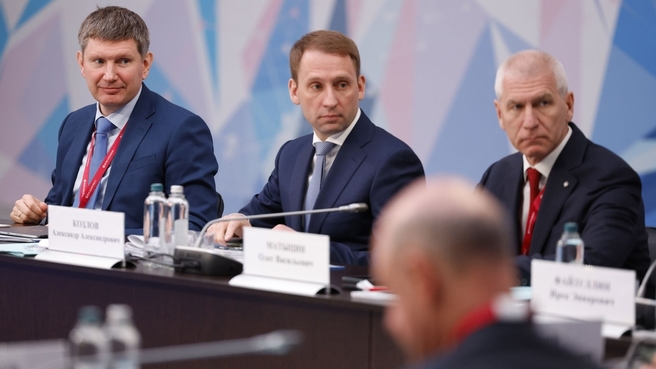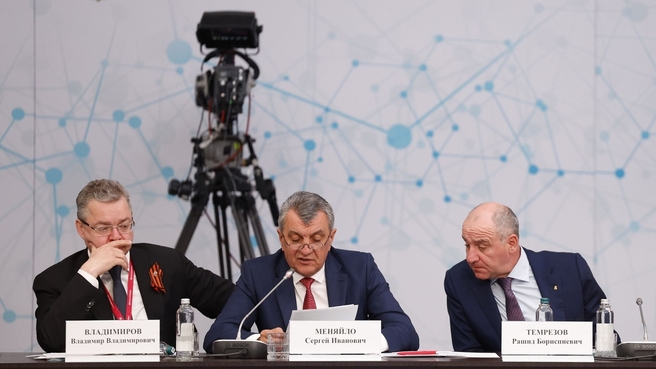Mikhail Mishustin: "On the whole, we can see positive trends in the development of the district. Last year, investment in fixed assets reached almost eight percent. There is also growth in industry. The volume of domestically produced goods has increased."
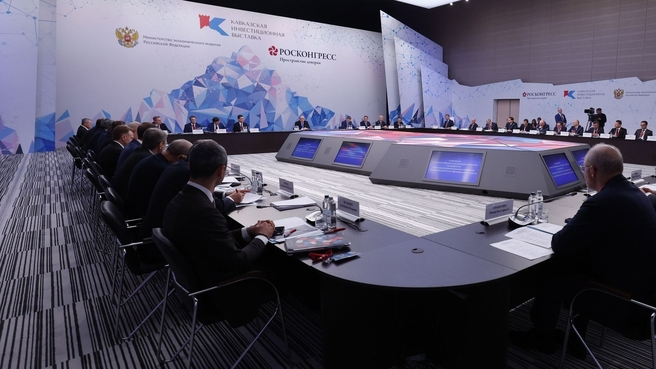
Meeting with members of the Government Commission on the Socioeconomic Development of the North Caucasus Federal District
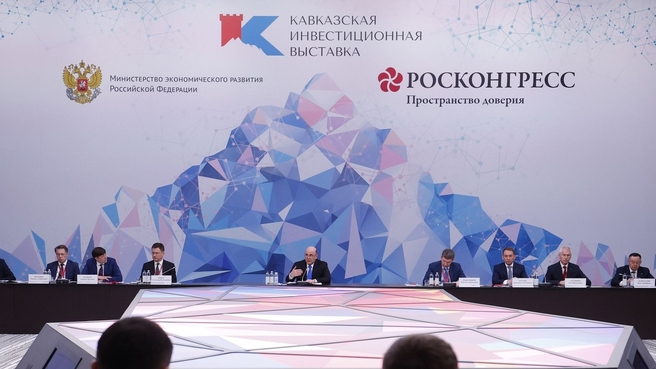
Meeting with members of the Government Commission on the Socioeconomic Development of the North Caucasus Federal District
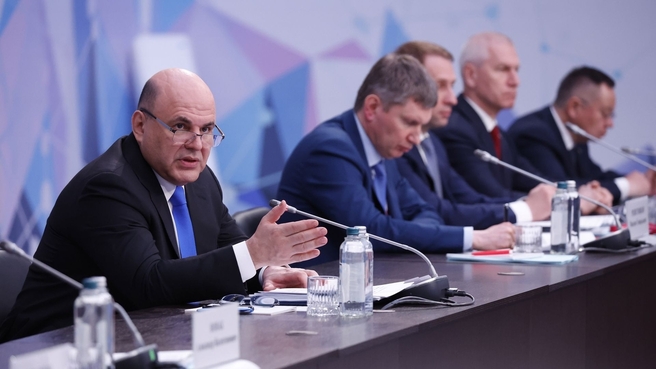
Meeting with members of the Government Commission on the Socioeconomic Development of the North Caucasus Federal District
Meeting with members of the Government Commission on the Socioeconomic Development of the North Caucasus Federal District
Mikhail Mishustin’s opening remarks
Good afternoon, colleagues.
Today, at a meeting of the Government Commission, we will discuss key issues in the development of the North Caucasus. We are holding this meeting in the district with the participation of representatives of all its constituent entities to assess the situation in detail.
The President has noted that the North Caucasus republics have every opportunity to maximise their rich potential and ensure the growth of key economic indicators.
I have just seen this for myself while visiting the Caucasus Investment Exhibition. It showcases interesting projects in a variety of sectors, including agriculture, industry, tourism, energy, construction and transport. There are opportunities for increasing domestic production and for developing new logistics routes.
Thank you very much for the invitation to visit it.
This is a solid foundation for systematic joint work and for implementing the tasks the President sets us.
Alexander Novak will speak about the exhibition in more detail.
On more than one occasion, the President has emphasised the special significance of the North Caucasus for our multi-ethnic country.
At the last commission meeting, we identified a number of problems in healthcare, education and certain industries, primarily in housing and utilities, where we needed to stabilise the operation of utilities, increase payment collection rates and put settlements in order so that these difficulties would not hold back regional development. Of course, the pandemic and restrictions from unfriendly countries have also had an impact on the socioeconomic situation in the North Caucasus.
I spoke in detail about the situation in the Federal District during last week’s four meetings with the governors as well as during my trip to Karachayevo-Circassia where we talked to employees of many businesses and their executives (by the way, I see them here today).
These meetings are essential for making well-balanced decisions with consideration for the opinions of our people, that is, the feedback that the President is talking about.
Overall, we are seeing positive dynamics in the development of the North Caucasus. Much has been done to enhance the investment appeal of its regions. Last year, investment in fixed assets reached almost 8 percent. Industry is also on the upsurge. The region is producing more goods of its own making, as we saw today on the stands at the exhibit.
Unemployment has decreased substantially – to about 10 percent. In the past three years, it went down another 3.6 percent. The number of employed people has increased by almost 4.5 percent and today surpassed 4 million people.
The President noted that we should evaluate any project in the North Caucasus by important criterion like the creation of new jobs. The current changes in the employment structure point to employers’ higher need for qualified labour.
Credit for these results largely goes to the support by the President and the Government, and of course, the work of the regional governors that have shown responsibility in resolving these problems.
They have created conditions for the regions to bring in revenue themselves, while budget funds have become a guarantee for attracting private capital into new projects. Economic development models were the main tool that we decided to introduce two years ago. They made it possible to synchronise the efforts of the Government, the Ministry of Economic Development, other departments, the regions and state corporations.
Models were made for every region in the Federal District. We discussed them for a long time at many strategic sessions. I would like to thank Alexander Novak and naturally, Yury Chaika, the Plenipotentiary Envoy, for their work – we produced all this together. We are also grateful to the esteemed regional governors. The managerial decisions we adopted after this analytical work have produced today’s breakthrough projects.
In all regions, we determined five key issues and five cluster-type breakthrough projects. The latter envision dozens of investment sub-projects, mostly, in strong areas like the agro industry and the hospitality industry. This is the case if you take it as a whole.
You described many of these projects during the exhibition. They brought in over 240 billion roubles to the regions and helped them create over 9,000 jobs. Twelve of these investment sub-projects have already been completed while another 79 projects are in different stages. Importantly, both the regions and the federal Government are carefully monitoring them.
We also continue implementing the goals of the state programme for the development of the North Caucasus. Work is underway to reach the goals of the national projects there as well. In providing government support to the Russian regions, we envisioned measures they can use themselves to attract businesses. These include budget loan restructuring. With this mechanism, the regions can redirect the funds saved to the construction of the needed facilities.
Infrastructure budget loans have also proved to be much in demand. Last week, following the President’s instruction, we allocated another 190 billion roubles for this purpose. Companies can also take a long-term loan at a low rate of 5.25 percent via the cluster investment platform if they develop production of priority products in Russia.
Moreover, to implement projects, including large ones, companies can receive investment loans at 3 percent interest in the North Caucasus. Today, we discussed this with the executives of Kavkaz.RF company. We have created new instruments for equity and debt financing to allow investors to be more flexible in running their projects, reducing their risks and improving their financial performance.
Minister of Economic Development Maxim Reshetnikov will talk about support for businesses in more detail later.
Now I would like to say a few words about the most important areas, areas that every region focuses on. These include tourism, agriculture, transport and industry. Development in these areas helps create growth points in the regions of the North Caucasus.
This is how it works with the hospitality industry; new resorts create jobs not only at the tourist facilities but also in the adjacent sectors. In general, tourism is the biggest multiplier in this regard. It leads to the development of everything else – from construction to retail trade. The demand for comfortable domestic travel of all kinds is increasing all the time. Everyone is talking about this now. Practically all regions are receiving higher tourist flows.
The North Caucasus has tremendous advantages in this respect. It is a beautiful area with many opportunities for rest and recreation. It has a unique location, favourable climate and amazing places. However, it needs infrastructure to develop not only traditional resorts and alpine skiing but also year-round services, beach holidays and eco-tourism. We saw many projects on this kind of tourism at the exhibition.
Agriculture is another area where the North Caucasus is confidently in the lead. It is doing much for agricultural security of the country. Agro businesses are making more use of modern technology. They are planting high-intensity gardens that produce more apples and pears. We were shown many projects for this purpose today. They are also interested in developing aqua-culture. Traditional sheep breeding is also being upgraded through selection and genetic research and modernised processing. We are also localising the elements of industrial production, which will help develop these sectors.
We need to provide our agriculture industry with the necessary facilities for storing produce and provide for the prompt delivery of perishable goods. The North Caucasus is also a region of great geostrategic importance due to its location in the global North-South transport corridor and its access to the Caspian Sea. Mr Melikov and I have discussed in detail the possible options for the development of these projects.
Under the current conditions, the North Caucasus is becoming a key transport and logistics hub in the North-South international corridor. So we certainly need to build water and road connections with the necessary infrastructure. This will provide additional opportunities for boosting the supplies of Russian goods to new and promising markets.
Good prospects are opening up for other industries, too. Four industrial clusters have been set up in the North Caucasus Federal District, and there is the Monocrystal Technology Park in the Stavropol Territory; Mr Vladimirov spoke about this at length today. Our colleagues also said that some of the major facilities have been thoroughly upgraded and restarted as part of breakthrough projects. All of them are of great importance for the country in terms of boosting domestic industry and ensuring Russia’s technological sovereignty.
A good foundation has been laid in the strongest sectors in the North Caucasus. Consistent implementation of all planned initiatives will lift the regional economy to a qualitatively new level. And we all felt this today; our discussions at the forum have made us more confident.
However, to continue to maintain such positive dynamics, local companies will need qualified personnel. As you know, cadres are the key. This is equally true of workers with secondary vocational training, as well as those with university degrees. This question is of great concern to company executives. The government is working on it systematically, training workers literally from school. I think that Minister Sergei Kravtsov will agree with me.
A lot has been done here. The two projects, Professionality and Advanced Engineering Schools, have been launched. Apart from these, we have specifically developed a comprehensive programme for secondary vocational education in the North Caucasus at the President’s instruction.
In the next three years, we will modernise local colleges and repair them. We will purchase equipment for them, and organise professional development courses for teachers. We will see what we can do with the clusters, because it is imperative that the region provides us with the terms of reference, if you like, with regard to the needed professions. So when you have a vision of the region’s socioeconomic development, we will be able to work out a relevant long-term personnel training strategy.
With this approach, colleges and universities will be able to educate the required number of qualified employees and resolve the personnel issues in each of the regions in the North Caucasus. But it is also very important for people to have jobs and stable incomes, which means higher living standards. By the way, one of the performance indicators that we have agreed on is growth in real income in all regions of the Russian Federation. And that certainly includes the regions in the Caucasus.
Colleagues, friends, today we will assess the situation in key areas, review the interim results, and set objectives for the end of this year.
We have plenty of issues to discuss, and an extensive agenda. Let's move on to the discussion.
